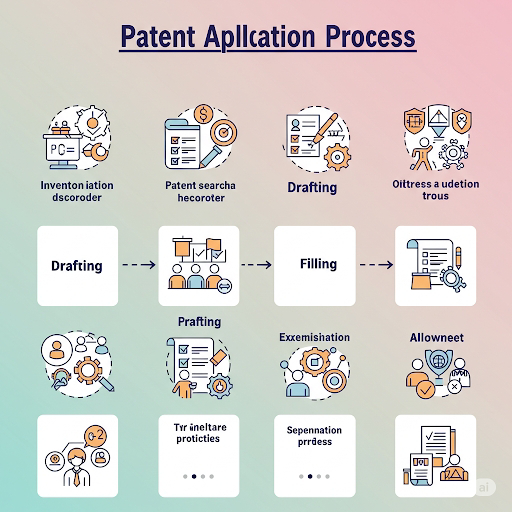How to Obtain a Patent: A Step-by-Step Guide for Inventors and InnovatorsA. Introduction
How to Obtain a Patent: A Step-by-Step Guide for Inventors and Innovators
A. Introduction
Innovation is the driving force of progress in today’s economy, and protecting your innovative ideas is just as important as developing them. A patent provides inventors with an exclusive legal right to use, make, sell, or license their inventions for a specific period. It acts as a shield against unauthorized use by others and adds value to businesses, startups, and research-based enterprises.
This article provides a step-by-step guide to understanding the patent registration process, with particular reference to Indian law (governed by the Patents Act, 1970), though the overall process is similar in many jurisdictions.
B. What is a Patent?
A patent is an exclusive right granted to an inventor for a novel invention that is capable of industrial application. It may be a product, process, machine, software, or technical improvement, provided it meets the statutory criteria.
C. Eligibility Criteria: What Can Be Patented?
An invention must meet the following conditions:
1. Novelty – The invention must be new and not known to the public anywhere in the world before the date of filing.
2. Inventive Step – It must involve a non-obvious technical advancement.
3. Industrial Applicability – It should be capable of being made or used in some form of industry.
4. Patentable Subject Matter – It must not fall under non-patentable categories like abstract ideas, algorithms, or traditional knowledge (Section 3 and 4 of Indian Patents Act).
D. Step-by-Step Process to Obtain a Patent
1. Document Your Invention: Clearly describe your invention with drawings, flowcharts, or diagrams. Include: a. Purpose, b. Functionality, c. Technical process or steps, d. Advantages over existing technology. This documentation is crucial for drafting your patent application and proving inventorship.
2. Conduct a Patent Search: A prior art search helps determine if your invention is truly novel and patentable. You can search: a. Indian Patent Database: https://ipindiaservices.gov.in/publicsearch, b. WIPO’s Patentscope, c. Google Patents: https://patents.google.com. This step prevents duplication and strengthens your application.
3. Draft the Patent Application: There are two types of applications:
a. Provisional Application – Filed to secure an early priority date; gives you 12 months to file a complete specification.
b. Complete Specification – A full, detailed disclosure of the invention, including “claims” that define the legal scope of protection.
A well-drafted set of claims is critical, and it is advisable to seek assistance from a registered patent agent or attorney.
4. File the Patent Application: You can file: a. Online: https://ipindia.gov.in, b. Offline: At the appropriate Patent Office (based on applicant’s jurisdiction).
Required documents include: a. Patent specification (provisional or complete), b. Drawings or illustrations, c. Declaration of inventorship, d. Power of attorney (if filed through an agent), d.Fee payment (varies for individuals, MSMEs, and companies)
5. Publication of Application: The application is automatically published in the Patent Journal after 18 months from the filing date. You may also request early publication.
6. Request for Examination (RFE): To proceed further, you must file a Request for Examination within 48 months from the filing date. The Patent Office will then assign your application to an examiner.
7. Examination & Office Action: The examiner evaluates your application and issues a First Examination Report (FER), highlighting objections or requiring clarifications. You must respond within 6 months, extendable by 3 months. This stage may involve hearings or amendments to overcome objections.
8. Grant of Patent: Once all objections are cleared, the patent is granted, and your invention is officially protected. The grant is published in the Patent Journal, and you receive a Patent Certificate.
9. Validity: A patent is valid for 20 years from the filing date, subject to annual renewal fees.
E. Conclusion: Securing a patent can significantly strengthen your business by providing a competitive edge and enabling monetization through licensing or assignments. However, the process demands a strategic combination of legal precision and technical clarity. Inventors are strongly encouraged to consult patent professionals for drafting, filing, and prosecution of the application. With a granted patent in hand, you not only protect your innovation but also enhance your credibility, attract investors, and pave the way for commercial success.
Thank you for reading.
Authored by:
Advocate Ranjitsinh Sureshrao Ghatge 🦅
+919823044282
1910
28th Vaishakh 14234
18th May 2025

Comments
Post a Comment